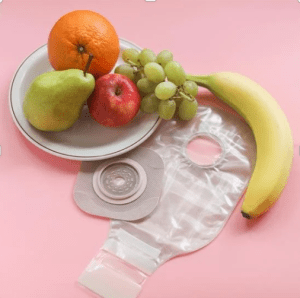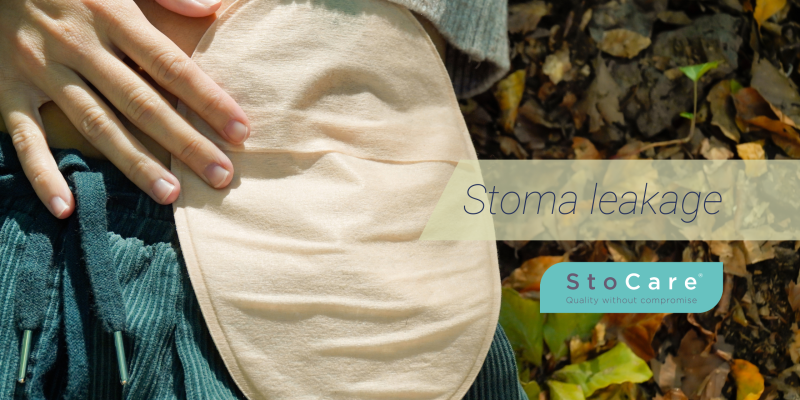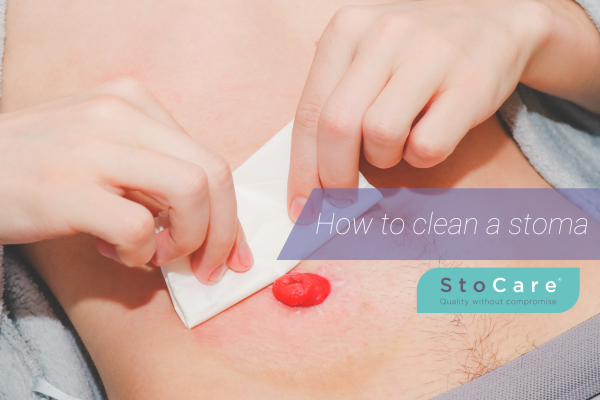Stoma leakage is unfortunately a common problem faced by people with a stoma – most will experience it at some point. However, although it is common, it’s not something you should have to put up with regularly, and it is not just a normal part of having a stoma. If your stoma bag is leaking repeatedly, this is likely to have a detrimental impact on your well-being, and it is a sign that something is not right.
Read our guide to stoma leakage to find out how to stop your stoma bag leaking.
What is stoma leakage?
Stoma leakage is when output from your stoma does not enter your stoma pouch as it should. It may get stuck between your skin and your baseplate (also known as a flange, wafer or skin barrier) or seep underneath the baseplate. It may leak onto your surrounding skin or clothing, or you may notice it on the adhesive when you change your stoma pouch.
This can vary from a small leak that you barely notice to a large leak that impacts your day. However big or small, you should change your appliance if it has leaked and consider what may have caused it so that you can take steps to prevent it from happening again.
Stoma leakage problems can happen to anyone, including those with a colostomy, ileostomy or urostomy. It is more likely to occur recently after stoma surgery. This is because you have likely not yet settled into a stoma bag changing routine – not to mention your stoma will change size and shape following surgery, making it difficult to get a stoma bag to fit perfectly. If this is you, don’t worry – it will get better and the number of leakages will decrease as you get used to your stoma.
How common is stoma leakage?
One study found that 30% of ostomates experience stoma leakage. It’s one of the most common stoma problems. However, it’s not normal to experience stoma leakage very frequently.
If leaks are happening frequently and are causing you anxiety or preventing you from making social plans with family and friends, have a chat with your stoma nurse who can help you find a solution. However, most leakages can be controlled with a few adjustments or product changes which we discuss below.
Why does my stoma bag keep leaking?
Whilst leakages can occur occasionally, perhaps because of changes in your routine, it isn’t something you should have to deal with on a regular basis. If your stoma bag keeps leaking, there is likely a cause behind it that you can tackle.
Here are common things that can cause a stoma bag to leak:
High output
If you have a very high output stoma or liquid output, you may be more likely to experience stoma leakage. You may benefit from emptying or changing your stoma pouch more often; setting alarms or writing reminders can help encourage you to do this. Speak to your stoma nurse if you feel your output is very high; they can help you to solve it, for example, by taking medication.
The consistency and frequency of your output will change depending on your diet (whether your stoma outputs faeces or urine). Keeping a food diary can help identify trigger foods. Our blog on foods to eat with a stoma explains what foods are most likely to cause a stoma leak and what foods you can eat to reduce and thicken your stoma output.

Poorly fitting appliance
If your ostomy appliance does not fit properly, it can cause leakage and skin irritation. The appliance needs to fit snugly around your stoma.
Your stoma may change size or shape over time, particularly in the weeks following surgery, which will mean your pouch will need adjustments. It will also change size and shape if you have a parastomal hernia or your stoma has prolapsed. In these instances, you should hold off from pre-cutting your pouches.
If you feel your pouch isn’t being cut to the correct size, you can remeasure it. Your stoma nurse can help with this if you are unsure.
Incorrect choice of appliance
The size, shape and behaviour of your stoma all need to be considered when selecting the stoma pouching system for you. You do not have to continue using the items that were first prescribed to you after surgery, especially if you are experiencing stoma leakage. You can try free samples from different manufacturers to find the combination of products that works best for you.
If you have a flat or retracted stoma with leakage, a convex stoma bag could help. A convex design will encourage your stoma to protrude into the pouch and allow the output into it. Find out more in our ultimate guide to stoma bags.
Changes in body shape, including abdominal creases, may also require a different pouch type.
Not using correct supporting products
Most ostomates need to use supporting products alongside their stoma bag to ensure it works as it should. For example, a stoma seal is often recommended by stoma nurses when patients are encountering stoma leakage.
Seals mould around your stoma and protect your skin. The Ostoform FLOWASSIST seal has been specifically designed to prevent leaks. It combines mouldable skin protection and a directional flow component which helps to guide output into your pouch. This may be particularly useful if you have a highly fluidic output or an irregular stoma, such as if it is flat or retracted.
Sore skin around your stoma
The skin around your stoma may be red, inflamed, dry, itchy or moist due to breakdown of your skin’s natural barrier. All these conditions make it more difficult for your appliance to adhere properly to the skin. Unfortunately, this can lead to leakage, which is then likely to cause more skin soreness. If left untreated, a vicious cycle can develop, resulting in problematic peristomal skin conditions.
You can break this cycle using suitable products. A barrier film such as StoCare Protect gives a layer of protection, preventing stoma output and moisture from sitting on the surface of your skin and causing damage. Additionally, it enhances the adhesion of the stoma appliance and helps to minimise leakage.
It’s also important to be gentle when removing your stoma appliances, especially when your skin is sore. You should always use a medical adhesive remover such as StoCare Remove to prevent skin damage when changing your pouch.
Poor adhesion
You may also be experiencing leakage because your stoma bag has not stuck very well to your skin. To prevent this, ensure your skin is completely clean and dry before applying the bag – it won’t stick well to wet skin and this will cause skin issues as described above. Similarly, don’t use oily products on or around your peristomal skin.
Using flange extenders increases the adhesive area of your stoma bag and can help prevent it from lifting.
Exercising
Leakage during exercise might result from increased sweat, twisting, bending, or movement of your abdomen. Emptying your pouch before exercising is advisable. Consider wearing clothing that fits snugly to hold the pouch closer to your body and using flange extenders to increase the adhesive area of your baseplate. You can also purchase support garments which may help to keep your pouch in position. Read our full guide to exercising with a stoma to find out more.

Pancaking
Pancaking occurs when you have very thick output. It causes the layers of your stoma bag to stick together, creating a vacuum that hinders output movement and thus causes stoma leakage. Read our guide to pancaking
Stoma leakage prevention
So how do you stop a stoma from leaking? In summary, here is how to prevent stoma leakage:
- Empty/change your stoma bag frequently, adapting to your output, skin condition and routine.
- Ensure you are using the pouch that best suits your needs.
- Ensure you are using the correct products – such as seals, flange extenders, barrier films, stoma paste, support garments etc.
- Ensure your baseplate is being cut to the correct size.
- Take care of your peristomal skin by using medical adhesive remover and check it regularly for signs of irritation. Find out how in our guide to peristomal skin protection
- Take steps to reduce your output if you feel leakage is being caused by high or liquid output.
- Ensure your stoma bag is secured to your abdomen during all activities.
- Speak to your stoma nurse who will be able to provide tailored advice for your circumstances.
Stoma leakage FAQs
Why is my stoma bag leaking at night?
Many ostomates report that they frequently experience stoma leakages at night. This is likely because you don’t empty your bag as often overnight. Here are some steps to help manage stoma bag leaking at night:
- Follow the steps above to make sure your stoma pouching system is secure and suits your needs.
- Empty/change your stoma bag just before bed.
- Set an alarm or two to wake you up and remind you to change/empty your stoma bag in the night.
- You may benefit from making your final meal of the day earlier and smaller than usual to help reduce your stoma output at night.
- You may benefit from a high-output bag at night or using a night drainage system if you have a urostomy. Ask your stoma nurse about these.
- Speak to your stoma nurse about over-the-counter treatments which can help slow your output down.
- Don’t sleep on your stomach. Getting a V-shaped or body pillow can help to keep you in place.
- Be prepared for leaks to happen. You can use a waterproof mattress protector and puppy pads to protect sheets. Keep a change of pyjamas and all your stoma products by your bed for quick changes.
How often should I change my stoma bag?
It depends on the type of stoma you have and your output. There are no rules over precisely how many times you should change/empty your stoma bag, but you should aim to do so when it gets to around half full. You should change it immediately if it has leaked. If you have a drainable ileostomy or urostomy bag, or you use a two-piece system, wearing your baseplate for around 3 days is a good benchmark to aim for, as this allows you to regularly check the condition of your peristomal skin whilst reducing the impact of repeated adhesive removal.
What is the normal output per day for a stoma?
The output volume of a colostomy is about 150-220g daily. The output volume of an ileostomy is about 500-800ml daily. The output volume of a urostomy is about 1200ml daily. (source) Stoma output will vary from person to person, depending on many factors, including your diet. If you have high output that is causing leakages, your stoma nurse can recommend over-the-counter medications or dietary changes to help.
How often should the skin around the stoma be cleaned?
You should clean off any output that is on your stoma or surrounding skin at every bag change, and as soon as possible if it has leaked. This is because stoma output causes skin irritation. You don’t need to use soap – water and wipes should be sufficient. Ensure the skin is completely dry before applying your new bag. Don’t use any products containing alcohol or oily products. You can take your stoma bag off while you shower and wash it like any other part of your body, if you wish.
Final thoughts
Don’t suffer in silence. Regular stoma leaks and worry about leaks should not control your daily life. For help and support, reach out to your local stoma nurse.
Although all our articles are proofread by medical professionals, this information is for guidance only and does not replace advice given by your healthcare advisors.




